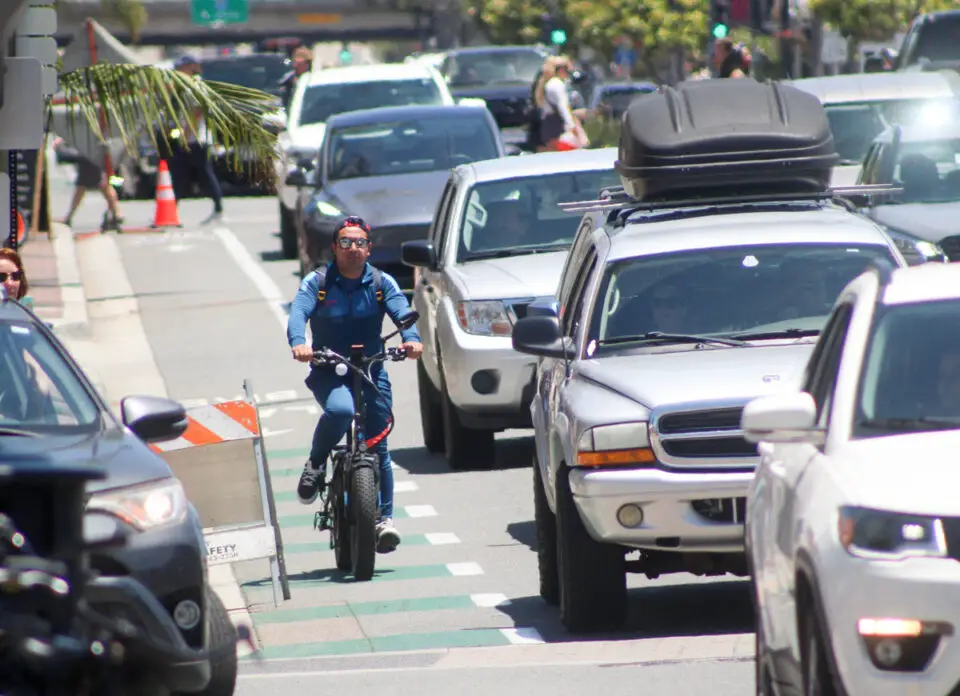REGION — The rising number of e-bike collisions in coastal North County San Diego over the past several years has sparked a growing demand for improved safety and regulatory measures for the increasingly popular mode of transportation.
In 2015, the California Legislature reclassified e-bikes — motorized bicycles powered by an electric battery— in Assembly Bill 1096 authored by former Assemblyman David Chiu (D-San Francisco).
Previously, e-bikes had been classified as “motorized bicycles.” However, the law, passed without any safety or impact studies and lobbied by special interest groups, re-classified e-bikes into the same category as traditional human-powered bicycles.
Since the change, and especially in the past four to five years, cities have been grappling with a significant increase in e-bike injuries and deaths. The U.S. Bureau of Economic Analysis reported cycling deaths have increased by more than 20% statewide from 2018-22.
Last August, two cyclists were killed while riding e-bikes within one week of each other in Carlsbad, prompting the city to declare a local state of emergency, citing a 233% increase in collisions involving bikes and e-bikes since 2019, and launch its Safer Streets Together campaign.
Most recently, a 15-year-old was struck and killed while riding an e-bike last month in Encinitas. The community’s shock over the teenager’s death resulted in the Encinitas City Council ratifying a local state of emergency on June 28 related to e-bikes, bikes and vehicle safety.
What the law changed
In the reclassification of e-bikes, California lawmakers identified three types of e-bikes, none of which are subject to registration, licensing, or insurance requirements applied to vehicles:
- A Class 1 e-bike has a top assisted speed of 20 mph and must be pedaled to operate;
- A Class 2 e-bike has a top assisted speed of 20 mph that can be operated without pedaling by using a handlebar-mounted throttle;
- A Class 3 e-bike has a top assisted speed of 28 mph that must be pedaled to operate. Riders must be at least 16 years old.
The law requires e-bike manufacturers to label each bike with its classification number, top assisted speed and motor wattage. A 750-watt e-bike motor, the state maximum, can produce top speeds of 28 mph. Nearly all e-bikes are permitted in designated California bikeways (bike paths, bike lanes, protected lanes and bike routes) with the exception of Class 3 (not permitted along bike paths or in protected lanes).

A “motorized bicycle,” or moped, is a two- or three-wheeled “device” with or without operating pedals powered by electrical energy, an automatic transmission, and a motor of four horsepower or less with a top speed of no more than 30 mph. No one under 21 can be issued a class M1 or M2 license (motorcycles and mopeds, respectively) unless they complete a motorcycle training program.
School reactions
Local school districts have started requiring students to first obtain a permit before riding an e-bike to school. A school district in Orange County even requires payment for students to secure an e-bike license, according to Tim Evanson, executive director of pupil services at Carlsbad Unified School District.
Students riding e-bikes to school in the Carlsbad Unified School District must submit an application and attend a bike/e-bike safety presentation to receive a mandatory permit, a process the district started earlier this year. Evanson said about 10% of the student population rides an e-bike and most of the riders have already attended the safety presentation, which the district plans to make an annual process.
The school district also partners with Carlsbad Police Department, San Diego Bicycle Coalition and California Highway Patrol to offer safety courses and training, including four summer sessions from 8 a.m. to 1 p.m. on July 10 and Aug. 7 at Poinsettia Elementary School and Sage Creek High School, and Sept. 9 at Poinsettia and Valley Middle School. The fourth date is yet to be determined.
The classes are conducted by the Carlsbad Police Department, which received training through a partnership with the San Diego Bicycle Coalition.
Data on collisions
In March 2022, Carlsbad police reported 186 collisions from Jan. 1, 2019, through Dec. 29, 2021. Of those, 163 resulted in injuries to one or more parties. Between January 2020 and July 2021, there were 99 collisions. Of those, the cyclist was determined to be at fault in 72 incidents, according to law enforcement.
Between 2018 and 2022, the Sheriff’s Department reported 235 traffic collisions along local roads in Encinitas, Del Mar and Solana Beach. But collisions involving bicycles and e-bikes in those same cities have increased by 50% last year when compared to 2018, with the majority of incidents occurring in Encinitas.
Lt. Ryan Wisniewski, of the San Diego County Sheriff’s Department, said while the e-bike collision rate in Encinitas, Del Mar and Solana Beach has risen, e-bike collisions overall are on pace to see a decline this year. As of June 29, just eight e-bike-related collisions were reported compared to 44 incidents in 2022, according to Wisniewski.

But the lower number of collisions has produced devasting outcomes and includes the recent death of Brodee Champlain-Kingman, 15, of Encinitas, who died after his e-bike collided with a work van on June 23 along El Camino Real.
“It’s way different because you’re not going the same speed as an e-bike,” Wisniewski said. “It’s very popular and they’re fun. I’d much rather see a kid riding a bike than playing video games. But when you see them riding down (Coast Highway) 101 or some of the major thoroughfares like El Camino, they’re going 20 mph on an e-bike and cars are going 50 mph, you’re asking a 12-year-old to make a split-second decision like they’re a regular driver with no driver safety program or training.”
Resident, law enforcement response
Residents are taking to social media and public meetings to share their apprehension about the growing prevalence of e-bikes along local roadways. Simultaneously, bike enthusiasts continue to stress the dangers of motorists not paying attention to cyclists sharing the road.
The long-time rivalry has played out in public forums, but law enforcement and local governments are trying to bridge the gap through education and enforcement, according to Wisniewski.
Encinitas resident James Giles, who recently had a family member involved in a bike-vehicle collision, said drivers must better pay attention as more cyclists are taking to the roads. On June 21, Giles’ son, Aiden, was struck by a vehicle and landed on the windshield while riding his bike along El Camino Real. Aiden did not suffer any major injuries.
“I think we need to do more for the cyclists themselves,” James Giles said. “I don’t know what that would look like, but some education and possibly certification would probably be a good thing. We need to change our attitudes about where bicycles belong. I think there’s a general attitude here that the cars own the road and the cyclists don’t belong there.”
According to Wisniewski, a greater concentration of e-bikes appears to be within more densely-populated cities along the coast. In addition, the relatively high cost of an e-bike (between $1,500 to $5,000) places a greater number of e-bikes in more affluent areas, such as Encinitas and Carlsbad.
Wisniewski said cyclists, regardless of age, must learn hand signals and other rules of the road, such as properly changing lanes and coming to a complete stop at stop signs and red lights. Younger e-bike riders with less experience navigating the roads and traveling at a higher rate of speed can have difficulty changing lanes. And that’s not accounting for motorists who fail to provide enough space for cyclists.
“You have everyone on the road and they’re not used to seeing all these e-bikes,” Wisniewski said. “Now you got nine, 10, 11 kids on e-bikes, and from a driver’s perspective, they’re not used to seeing that many modes of transportation on the roads all of a sudden.”
Laura Place contributed to this report.




